An Assessment of Water Sources for Heritage Listed Organic Mound Springs in NW Australia Using Airborne Geophysical (Electromagnetics and Magnetics) and Satellite Remote Sensing Methods
Abstract
:1. Introduction
2. Background
2.1. Hydrogeological Setting
2.2. AEM Data Acquisition, Inversion and Analysis
2.3. Geological and Hydrogeological Interpretation of Geophysical Datasets
3. Park-Scale Spring Source Assessment: Methodology
3.1. Geophysics—Time Domain Airborne Electromagnetics
AEM Data Inversion
3.2. Remote Sensing Data
Fractional Cover Model
4. Results
4.1. D Fine Scale AEM Inversion
4.2. Two-Dimensional Fine-Scale AEM Inversion
4.3. Fractional Cover Model
5. Discussion
6. Conclusions
Author Contributions
Funding
Data Availability Statement
Acknowledgments
Conflicts of Interest
Appendix A. Fixed-Wing AEM System
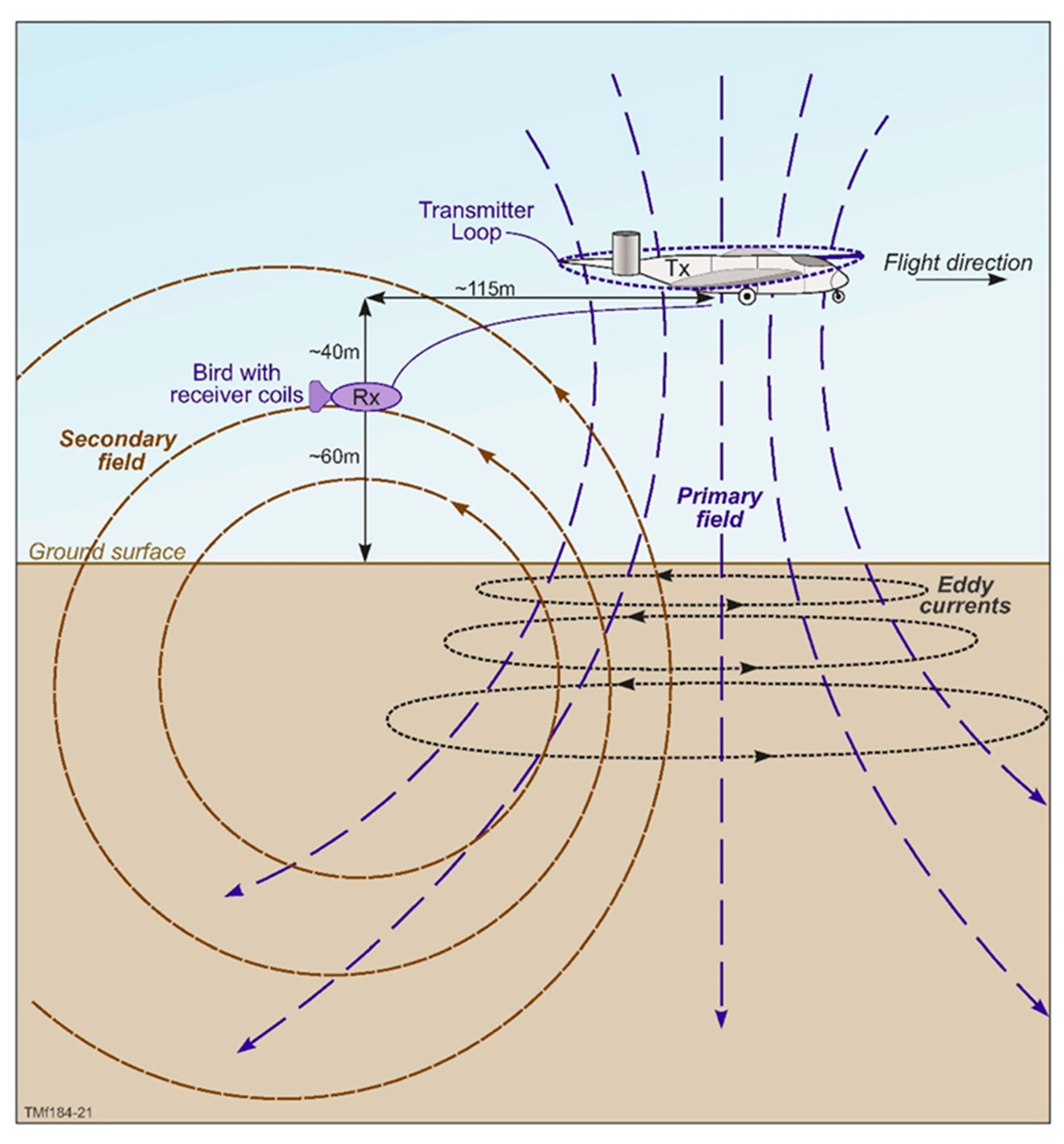
References
- Guo, M.; Li, J.; Sheng, C.; Xu, J.; Wu, L. A Review of Wetland Remote Sensing. Sensors 2017, 17, 777. [Google Scholar] [CrossRef] [Green Version]
- White, D.C.; Lewis, M.M. A new approach to monitoring spatial distribution and dynamics of wetlands and associated flows of Australian Great Artesian Basin springs using QuickBird satellite imagery. J. Hydrol. 2011, 408, 140–152. [Google Scholar] [CrossRef] [Green Version]
- Department of Parks and Wildlife (DPaW). Parks and Reserves of the South-West Kimberley and North-West Pilbara—Draft Joint Management Plan 2016; Department of Parks and Wildlife: Perth, Australia, 2016. [Google Scholar]
- Storey, A.W.; Halse, S.A.; Shield, R.J.; Creagh, S. Aquatic fauna and water chemistry of the mound springs and wetlands of Mandora Marsh, north-western Australia. J. R. Soc. West. Austr. 2011, 94, 419–437. [Google Scholar]
- Quinlan, K.; Pinder, A.; Lewis, L. Aquatic Fauna Survey at Mandora Marsh (Walyarta) in September 2015: Pre-pared for Parks and Wildlife’s Kimberley Region; Department of Parks and Wildlife: Kensington, Australia, 2016. [Google Scholar]
- Department of Conservation and Land Management (CALM). A Land Management Assessment of Mandora Marsh and its Immediate Surrounds; Graham, G., Ed.; Unpublished Report; Department of Conservation and Land Management: Perth, WA, Australia, 1999. [Google Scholar]
- English, V.; Luu, R.; Coote, M. Survey of Mandora Mound Springs and Salt Creek, Walyarta; Department of Parks and Wildlife: Kensington, WA, Australia, 2016. [Google Scholar]
- Markey, A. Mandora Marsh / Walyarta Flora and Floristic Vegetation Survey: 2015. Progress Report; Department of Parks and Wildlife: Kenisngton, WA, Australia, 2017. [Google Scholar]
- Wyrwoll, H.; McKenzie, N.L.; Pederson, B.J.; Tapley, I.J. The Great Sandy Desert of northwestern Australia: The last 7000 years. Search 1986, 17, 208–210. [Google Scholar]
- Harrington, G.A.; Harrington, N.M. Hydrochemistry of Peat Mound Springs within Mandora Marsh, West Canning Basin, WA; A Report Prepared for Department of Parks and Wildlife, Western Australia by Innovative Groundwater Solutions; Innovative Groundwater Solutions: Wayville, SA, Australia, 2017. [Google Scholar]
- Leech, R.E.J. Geology and Groundwater Resources of the Southwestern Canning Basin, Western Australia; Geological Survey of Western Australia; Record 1979/9; Department of Mines, Industry Regulation and Safety: Perth, WA, Australia, 1979; ISBN 072448034X. [Google Scholar]
- Aquaterra. West Canning Basin Modelling Project; Report to the Western Australian Department of Water by Aqua-terra Consulting Pty Ltd.: Kenisngton, WA, Australia, 2010. [Google Scholar]
- Aldam, R.; Kuang, K. An Investigation of Structures Controlling Discharge of Spring Waters in the South Western Great Artesian Basin; Adelaide SA: Report Book 88/4; Department of Mines and Energy: Adelaide, SA, Australia, 1988. [Google Scholar]
- Krieg, G.W.; Rogers, P.A.; Callen, R.A.; Freeman, P.J.; Alley, N.F.; Forbes, B.G. Curdimurka, South Australia. Explanatory notes. 1:250,000 Geological Series—Sheet SH 53-8; Geological Survey of South Australia: Adelaide, Australia, 1991. [Google Scholar]
- Inverarity, K.; Heinson, G.; Hatch, M. Groundwater flow underneath mound spring tufas from geophysical surveys in the southwestern Great Artesian Basin, Australia. Aust. J. Earth Sci. 2016, 63, 857–872. [Google Scholar] [CrossRef]
- Halihan, T.; Love, A.; Keppel, M.; Dailey, M.K.M.; Berens, V.; Wohling, D. Evidence for groundwater mixing at Freeling Spring Group, South Australia. Hydrogeol. J. 2019, 28, 313–323. [Google Scholar] [CrossRef] [Green Version]
- Becker, M.W. Potential for Satellite Remote Sensing of Ground Water. Ground Water 2006, 44, 306–318. [Google Scholar] [CrossRef] [PubMed]
- Pastick, N.J.; Jorgenson, M.T.; Wylie, B.K.; Minsley, B.J.; Ji, L.; Walvoord, M.A.; Smith, B.D.; Abraham, J.D.; Rose, J.R. Extending Airborne Electromagnetic Surveys for Regional Active Layer and Permafrost Mapping with Remote Sensing and Ancillary Data, Yukon Flats Ecoregion, Central Alaska. Permafr. Periglac. Process. 2013, 24, 184–199. [Google Scholar] [CrossRef] [Green Version]
- Liu, X.; Zhu, X.; Zhu, W.; Pan, Y.; Zhang, C.; Zhang, D. Changes in Spring Phenology in the Three-Rivers Headwater Region from 1999 to 2013. Remote. Sens. 2014, 6, 9130–9144. [Google Scholar] [CrossRef] [Green Version]
- Albano, C.M.; McGwire, K.C.; Hausner, M.B.; McEvoy, D.J.; Morton, C.G.; Huntington, J.L. Drought Sensitivity and Trends of Riparian Vegetation Vigor in Nevada, USA (1985–2018). Remote. Sens. 2020, 12, 1362. [Google Scholar] [CrossRef]
- Alshehri, F.; Sultan, M.; Karki, S.; Alwagdani, E.; Alsefry, S.; Alharbi, H.; Sahour, H.; Sturchio, N. Mapping the Distribution of Shallow Groundwater Occurrences Using Remote Sensing-Based Statistical Modeling over Southwest Saudi Arabia. Remote Sens. 2020, 12, 1361. [Google Scholar] [CrossRef]
- Munier, S.; Carrer, D.; Planque, C.; Camacho, F.; Albergel, C.; Calvet, J.-C. Satellite Leaf Area Index: Global Scale Analysis of the Tendencies Per Vegetation Type Over the Last 17 Years. Remote Sens. 2018, 10, 424. [Google Scholar] [CrossRef] [Green Version]
- Pryet, A.; D’Ozouville, N.; Violette, S.; Deffontaines, B.; Auken, E. Hydrogeological settings of a volcanic island (San Cristóbal, Galapagos) from joint interpretation of airborne electromagnetics and geomorphological observations. Hydrol. Earth Syst. Sci. 2012, 16, 4571–4579. [Google Scholar] [CrossRef]
- Goebel, M.; Knight, R.; Halkjær, M. Mapping saltwater intrusion with an airborne electromagnetic method in the offshore coastal environment, Monterey Bay, California. J. Hydrol. Reg. Stud. 2019, 23, 100602. [Google Scholar] [CrossRef]
- Paine, J.G. Determining salinization extent, identifying salinity sources, and estimating chloride mass using surface, borehole, and airborne electromagnetic induction methods. Water Resour. Res. 2003, 39, 1059. [Google Scholar] [CrossRef] [Green Version]
- Siemon, B.; Vest Christiansen, A.; Auken, E. A review of helicopter-borne electromagnetic methods for groundwater exploration. Near Surf. Geophys. 2009, 7, 629–646. [Google Scholar] [CrossRef] [Green Version]
- Dickinson, J.E.; Pool, D.R.; Groom, R.W.; Davis, L.J. Inference of lithologic distributions in an alluvial aquifer using airborne transient electromagnetic surveys. Geophysics 2010, 75, WA149–WA161. [Google Scholar] [CrossRef] [Green Version]
- Oldenborger, G.; Logan, C.; Hinton, M.; Pugin, A.-M.; Sapia, V.; Sharpe, D.; Russell, H. Bedrock mapping of buried valley networks using seismic reflection and airborne electromagnetic data. J. Appl. Geophys. 2016, 128, 191–201. [Google Scholar] [CrossRef]
- Parra-García, M.; Sanchez, G.; Dentith, M.C.; George, A.D. Regional Structural and Stratigraphic Study of the Canning Basin; Report; Geological Survey of Western Australia: Perth, WA, Australia, 2014; Volume 140, 215p. [Google Scholar]
- Geological Survey of Western Australia (GSWA). Prospectivity of State Acreage Release Areas L12-8 and L12-9, Canning Basin; Geological Survey of Western Australia: Perth, WA, Australia, 2012; p. 10. [Google Scholar]
- Forman, D.J.; Wales, D.W. Geological Evolution of the Canning Basin, Western Australia, Bulletin 210 Bureau of Mineral Resources, Geology and Geophysics; Australian Government Publishing Service: Canberra, Australia, 1981. [Google Scholar]
- FrOG Tech 2005. OZ SEEBASETM v1 2005. Structural GIS. Available online: http://www.frogtech.com.au/seebase-range/ (accessed on 27 March 2021).
- Frogtech Geoscience. Canning Basin SEEBASE Study and GIS Data Package: Geological Survey of Western Australia; Report 182; Geology and Geophysics and Geological Survey of Western Australia: Perth, WA, Australia, 2017; p. 297. [Google Scholar]
- Towner, R.R. 1:250 000 Geological Series—Explanatory Notes: Mandora Western Australia Sheet SE/51-13 Interna-tional Index; Bureau of Mineral Resources, Geology and Geophysics and Geological Survey of Western Australia: Perth, WA, Australia, 1982; p. 22. [Google Scholar]
- Towner, R.R. 1:250 000 Geological Series—Explanatory Notes: Munro Western Australia Sheet SE/51-14 International Index; Bureau of Mineral Resources, Geology and Geophysics and Geological Survey of Western Australia: Perth, WA, Australia, 1982; p. 22. [Google Scholar]
- Towner, R.R.; Gibson, D.L. Geology of the onshore Canning Basin, Western Australia: Bureau of Mineral Resources, Geology and Geophysics. Bulletin 1983, 215, 51. [Google Scholar]
- Zhan, Y. A Seismic Interpretation of the Southwestern Canning Basin, Western Australia: Geological Survey of Western Australia; Report 178; Department of Mines, Industry Regulation and Safety: Perth, WA, Australia, 2018; p. 36. [Google Scholar]
- Zhan, Y. A Seismic Interpretation of the Broome Platform, Willara Sub-Basin and Munro Arch of the Canning Basin, Western Australia: Geological Survey of Western Australia; Report 193; Department of Mines, Industry Regulation and Safety: Perth, WA, Australia, 2019; p. 43. [Google Scholar]
- Department of Water (DoW). La Grange Groundwater Allocation Plan; Department of Water, Water Resource Allocation and Planning Report Series Report no. 25; The Department of Water and Environmental Regulation: Perth, WA, Australia, 2010. [Google Scholar]
- Department of Water (DoW). West Canning Basin Groundwater Allocation Limit Report—Background Information and Method Used to Set an Allocation Limit for Aquifers in the West Canning Basin. Department of Water, Water Resource Allocation and Planning Report Series Report no. 52; The Department of Water and Environmental Regulation: Perth, WA, Australia, 2012. [Google Scholar]
- NTEC Environmental Technology (NTEC). West Canning Basin Groundwater Model: Northstar Magnetite Project; Report for Fortescue Metals Group (FMG) Ltd. EPA Western Australia: Joondalup, WA, Australia, 2012. [Google Scholar]
- Paul, R.J.; George, R.J.; Gardiner, P.S. A Review of the Broome Sandstone Aquifer in the La Grange Area, Resource Management Technical Report 387; Department of Agriculture and Food: Perth, Australia, 2013. [Google Scholar]
- Pells Sullivan Meynink (PSM). West Canning Basin Groundwater Model Report, A Report to Department of Water and Environmental Regulation Perth Western Australia; The Department of Water and Environmental Regulation: Perth, WA, Australia, 2017; p. 394. [Google Scholar]
- Traves, D.M.; Casey, J.N.; Wells, A.T. The Geology of the South-Western Canning Basin, Western Australia. Commonwealth of Australia, Department of National Development, The Bureau of Mineral Resources, Geology and Geophysics; Report no 29; BMR; The Bureau of Mineral Resources, Geology and Geophysics: Canberra, ACT, Australia, 1956. [Google Scholar]
- Munier, S.; Maisongrande, P.; Becker, M.; Cazenave, A. Using GRACE to detect groundwater storage variations: The cases of Canning Basin and Guarani aquifer system. Int. Water Technol. J. 2012, 2, 2–13. [Google Scholar]
- Rutherford, J.; Greatwich, B.; Godfrey, N.; Rings, C.; Hunter, N.; McDonald, J. Seasonal Groundwater and Surface Water Interactions in the Walyarta Mound Springs and Mandora Lake: 2019–2020; Department of Biodiversity, Conservation and Attractions: Kensington, Australia, 2020. [Google Scholar]
- Markey, A.; Dillion, S. Draft Vegetation Map of the Walyarta Conservation Park: February 2019; Prepared for DBCAs Parks and Wildlife Services West Kimberley Region; Department of Biodiversity, Conservation and Attractions: Kensington, WA, Australia, 2019. [Google Scholar]
- Huntley, B. Walyarta-Preliminary Remote Sensing Report; Department of Parks and Wildlife: Perth, WA, USA, 2015. [Google Scholar]
- Rutherford, J.L.; Cendón, D.I.; Søerensen, C.; Batty, S.; Huntley, B.; Bourke, L.; Pinder, A.; Quinlan, K.; English, V.; Coote, M. Hydrological Conceptualisation of the Walyarta Mound Springs; Department of Biodiversity, Conservation and At-tractions, Wetlands Conservation Program: Perth, Australia, 2018. [Google Scholar]
- Meredith, K.; Han, L.; Cendón, D.; Crawford, J.; Hankin, S.; Peterson, M.; Hollins, S. Evolution of dissolved inorganic carbon in groundwater recharged by cyclones and groundwater age estimations using the 14C statistical approach. Geochim. Cosmochim. Acta 2018, 220, 483–498. [Google Scholar] [CrossRef]
- CGG. Department of Water TEMPEST Geophysical Survey West Canning Basin Survey, Western Australia: Logistics and Processing Report; Project Number: 2474; Bureau of Mineral Resources, Geology and Geophysics and Geological Survey of Western Australia: Perth, WA, Australia, 2016; p. 58. [Google Scholar]
- Lane, R.; Green, A.; Golding, C.; Owers, M.; Pik, P.; Plunkett, C.; Sattel, D.; Thorn, B. An example of 3D conductivity mapping using the TEMPEST airborne electromagnetic system. Explor. Geophys. 2000, 31, 162–172. [Google Scholar] [CrossRef]
- Lane, R.; Pracilio, G. Visualisation of Sub-Surface Conductivity Derived from Airborne EM. In Proceedings of the Symposium on the Application of Geophysics to Engineering and Environmental Problems 2000, Arlington, VA, USA, 20–24 February 2000; pp. 101–111. [Google Scholar] [CrossRef]
- Sattel, D.; Kgotlhang, L. Groundwater Exploration with Aem in the Boteti Area, Botswana. Explor. Geophys. 2004, 35, 147–156. [Google Scholar] [CrossRef]
- Roach, I.C. (Ed.) Geological and Energy Implications of the Paterson Province Airborne Electromagnetic (AEM) Survey, Western Australia; Record 2010/12; Geoscience Australia: Canberra, Australia, 2010; Record 2010/12. [Google Scholar]
- Roach, I.C.; Jaireth, S.; Costelloe, M.T. Applying regional airborne electromagnetic (AEM) surveying to understand the architecture of sandstone-hosted uranium mineral systems in the Callabonna Sub-basin, Lake Frome region, South Australia. Aust. J. Earth Sci. 2014, 61, 659–688. [Google Scholar] [CrossRef]
- Craig, M.A. (Ed.) Geological and Energy Implications of the Pine Creek Region Airborne Electromagnetic (AEM) Survey; Northern Territory, Australia. Record 2011/18, 292; Geoscience Australia: Canberra, Australia, 2011. [Google Scholar]
- Annetts, D.; Munday, T.; George, R.; Wright, N.; Raper, G.P.; Cahill, K. The Application of AEM to Mapping the Aquifer and Groundwater Characteristics of the La Grange Groundwater Area; WA: Final Report, Report EP165299; CSIRO: Perth, Australia, 2017. [Google Scholar]
- Ley-Cooper, A.Y.; Brodie, R.C.; Richardson, M. AusAEM: Australia’s airborne electromagnetic continental-scale acquisition program. Explor. Geophys. 2019, 51, 193–202. [Google Scholar] [CrossRef]
- Mira Geoscience. Inversion and Preliminary Interpretation of Airborne Electromagnetic Data from the West Canning Basin—Sandfire TEMPEST Survey; A Report Prepared for the Government of Western Australia, The Department of Water and Environmental Regulation: Perth, WA, Australia, 2016. [Google Scholar]
- Auken, E.; Vest Christiansen, A. Layered and laterally constrained 2D inversion of resistivity data. Geophysics 2004, 69, 752–761. [Google Scholar] [CrossRef]
- Auken, E.; Vest Christiansen, A.; Kirkegaard, C.; Fiandaca, G.; Schamper, C.; Behroozmand, A.A.; Binley, A.; Nielsen, E.; Effersø, F.; Christensen, N.B.; et al. An overview of a highly versatile forward and stable inverse algorithm for airborne, ground-based and borehole electromagnetic and electric data. Explor. Geophys. 2015, 46, 223–235. [Google Scholar] [CrossRef] [Green Version]
- Sørensen, C.C.; Munday, T.J.; Rutherford, J.L.; Cahill, K. Processing and Inversion of Mandora Marsh AEM Data: Enhanced TEMPEST Data Processing and Interpretation; CSIRO Technical Report EP 178999; CSIRO: Kensington, WA, Australia, 2007. [Google Scholar]
- Clark, D.; McPherson, A.; Collins, C.D.N. Australia’s Seismogenic Neotectonic Record: A Case for Heterogeneous Intraplate Deformation; Record 2011/11; Geoscience Australia: Canberra, Australia, 2011. [Google Scholar]
- Bailey, A.; Henson, P. Mapping Northern Australia’s Present Day Stress Field: The Canning Basin. ASEG Ext. Abstr. 2018, 2018, 1–6. [Google Scholar] [CrossRef] [Green Version]
- Brett, J.W. 80 m Magnetic 1VD Merged Grid of Western Australia 2020 Version 1: Geological Survey of Western Australia; Department of Mines, Industry Regulation and Safety: Perth, WA, Australia, 2000. [Google Scholar]
- V&C Semeniuk Research Group. Wetlands of the North-Western Great Sandy Desert; Unpublished; V&C Semeniuk Research Group: Perth, WA, Australia, 2000. [Google Scholar]
- Haig, T. The Pilbara Coast Water Study. Government of Western Australia, Department of Water Hydrogeological Record Series; Report no. HG34; Government of Western Australia; Wayville, SA, Australia, 2009. [Google Scholar]
- Knight, R.; Smith, R.; Asch, T.; Abraham, J.; Cannia, J.; Viezzoli, A.; Fogg, G. Mapping Aquifer Systems with Airborne Electromagnetics in the Central Valley of California. Ground Water 2018, 56, 893–908. [Google Scholar] [CrossRef] [Green Version]
- Reid, J.E.; Vrbancich, J. A comparison of the inductive-limit footprints of airborne electromagnetic configurations. Geophysics 2004, 69, 1229–1239. [Google Scholar] [CrossRef]
- Viezzoli, A.; Auken, E.; Munday, T. Spatially constrained inversion for quasi 3D modelling of airborne electromagnetic data—An application for environmental assessment in the Lower Murray Region of South Australia. Explor. Geophys. 2009, 40, 173–183. [Google Scholar] [CrossRef] [Green Version]
- Viezzoli, A.; Vest Christiansen, A.; Auken, E.; So̸rensen, K. Quasi-3D modeling of airborne TEM data by spatially constrained inversion. Geophysics 2008, 73, F105–F113. [Google Scholar] [CrossRef]
- Vest Christiansen, A.; Auken, E. A global measure for depth of investigation. Geophysics 2012, 77, WB171–WB177. [Google Scholar] [CrossRef]
- Paterson, R.; Silic, J.; Fitzgerald, D. Improved Structural Mapping and Conductive Targeting Delivered by a new 2.5D AEM Inversion Solver. ASEG Ext. Abstr. 2016, 2016, 1–8. [Google Scholar] [CrossRef] [Green Version]
- Silic, J.; Paterson, R.; FitzGerald, D.; Archer, T. Comparing 1D and 2.5D AEM inversions in 3D geological mapping using a new adaptive inversion solver. In Proceedings of the 14th International Congress of the Brazilian Geophysical Society & EXPOGEF, Rio de Janeiro, Brazil, 3–6 August 2015; Society of Exploration Geophysicists: Rio de Janeiro, Brazil, 2015. [Google Scholar]
- Wilson, G.; Raiche, A.; Sugeng, F. 2.5D inversion of airborne electromagnetic data. Explor. Geophys. 2006, 37, 363–371. [Google Scholar] [CrossRef] [Green Version]
- Flood, N.; Danaher, T.; Gill, T.; Gillingham, S. An Operational Scheme for Deriving Standardised Surface Reflectance from Landsat TM/ETM+ and SPOT HRG Imagery for Eastern Australia. Remote. Sens. 2013, 5, 83–109. [Google Scholar] [CrossRef] [Green Version]
- Muir, J.; Schmidt, M.; Tindall, D.; Trevithick, R.; Scarth, P.; Stewart, J. Guidelines for Field Measurement of Fractional Ground Cover: A Technical Handbook Supporting the Australian Collaborative Land Use and Management Program; Tech. Rep.; Queensland Department of Environment and Resource Management for the Australian Bureau of Agricultural and Resource Economics and Sciences: Canberra, Australia, 2011. [Google Scholar]
- Rutherford, J.; Cendón, D.I.; Madden, R.; Greatwich, B.; Godfrey, N.; Ibrahimi, T. (in prep) Hydrogeochemical and Mineralogical Evidence of Long-Term Groundwater Discharge in Organic Mound Springs in Semi-Arid North Western Australia.
- Curewitz, D.; A Karson, J. Structural settings of hydrothermal outflow: Fracture permeability maintained by fault propagation and interaction. J. Volcanol. Geotherm. Res. 1997, 79, 149–168. [Google Scholar] [CrossRef]
- Gudmundsson, A. Active fault zones and groundwater flow. Geophys. Res. Lett. 2000, 27, 2993–2996. [Google Scholar] [CrossRef]
- Faulkner, D.; Jackson, C.; Lunn, R.; Schlische, R.; Shipton, Z.; Wibberley, C.; Withjack, M. A review of recent developments concerning the structure, mechanics and fluid flow properties of fault zones. J. Struct. Geol. 2010, 32, 1557–1575. [Google Scholar] [CrossRef]
- Flood, N. Seasonal Composite Landsat TM/ETM+ Images Using the Medoid (a Multi-Dimensional Median). Remote. Sens. 2013, 5, 6481–6500. [Google Scholar] [CrossRef] [Green Version]
- CyMod Systems Pty. Ltd. Local Scale Solute Transport Modelling of Walyarta Conservation Park Using WCAMS V1.3; Report to Department of Biodiversity, Conservation and Attractions; CyMod Systems Pty. Ltd.: Bedfordale, WA, Australia, 2019. [Google Scholar]
- Bense, V.; Gleeson, T.; Loveless, S.; Bour, O.; Scibek, J. Fault zone hydrogeology. Earth-Sci. Rev. 2013, 127, 171–192. [Google Scholar] [CrossRef]
- Anderson, T.R.; Fairley, J.P. Relating permeability to the structural setting of a fault-controlled hydrothermal system in southeast Oregon, USA. J. Geophys. Res. Space Phys. 2008, 113, 1–13. [Google Scholar] [CrossRef] [Green Version]
- Rowland, J.C.; Manga, M.; Rose, T.P. The influence of poorly interconnected fault zone flow paths on spring geochemistry. Geofluids 2008, 8, 93–101. [Google Scholar] [CrossRef]
- Jung, N.-H.; Han, W.S.; Watson, Z.; Graham, J.P.; Kim, K.-Y. Fault-controlled CO2 leakage from natural reservoirs in the Colorado Plateau, East-Central Utah. Earth Planet. Sci. Lett. 2014, 403, 358–367. [Google Scholar] [CrossRef]
- Palacky, G. Use of airborne electromagnetic methods for resource mapping. Adv. Space Res. 1993, 13, 5–14. [Google Scholar] [CrossRef]

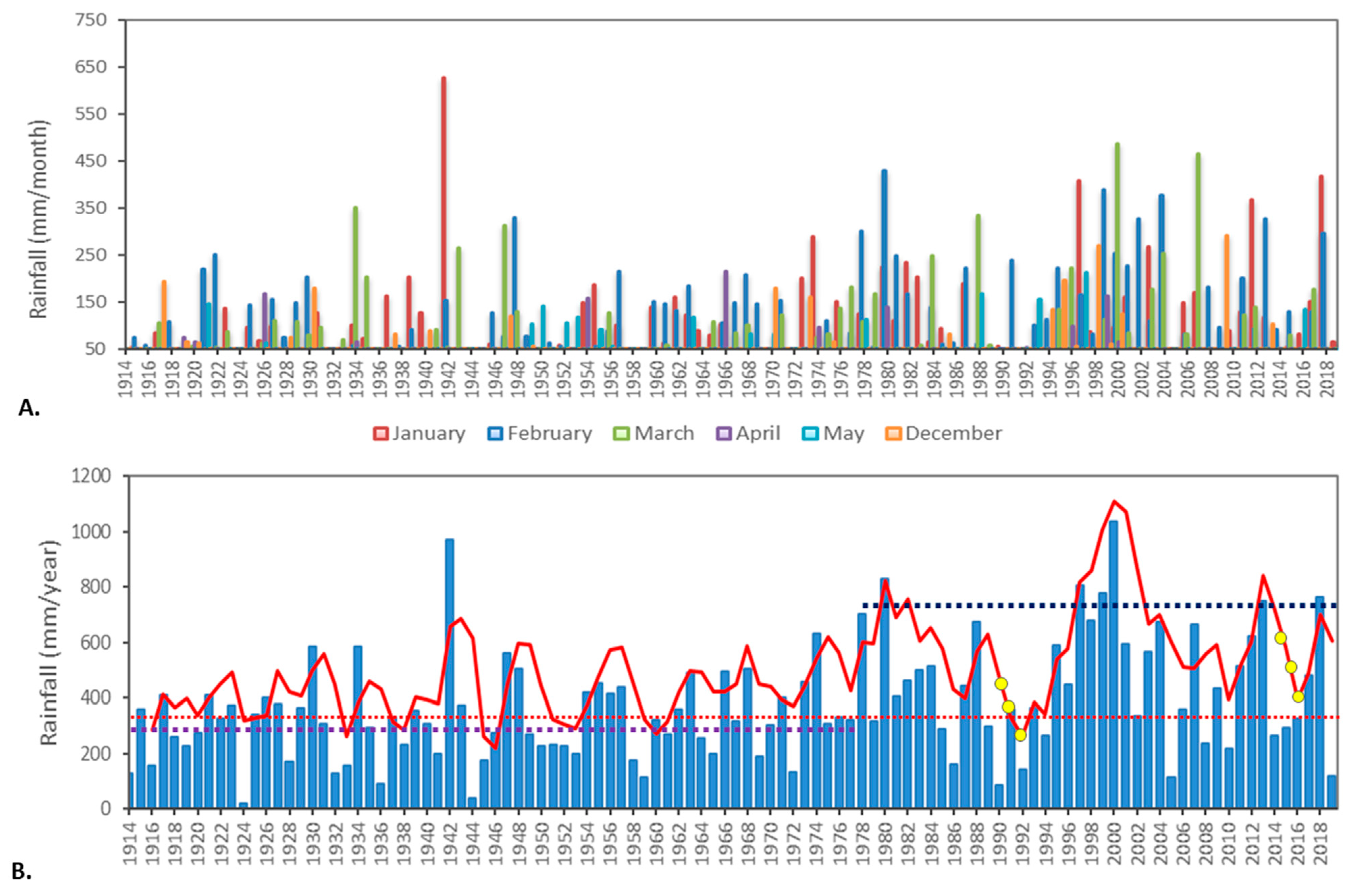

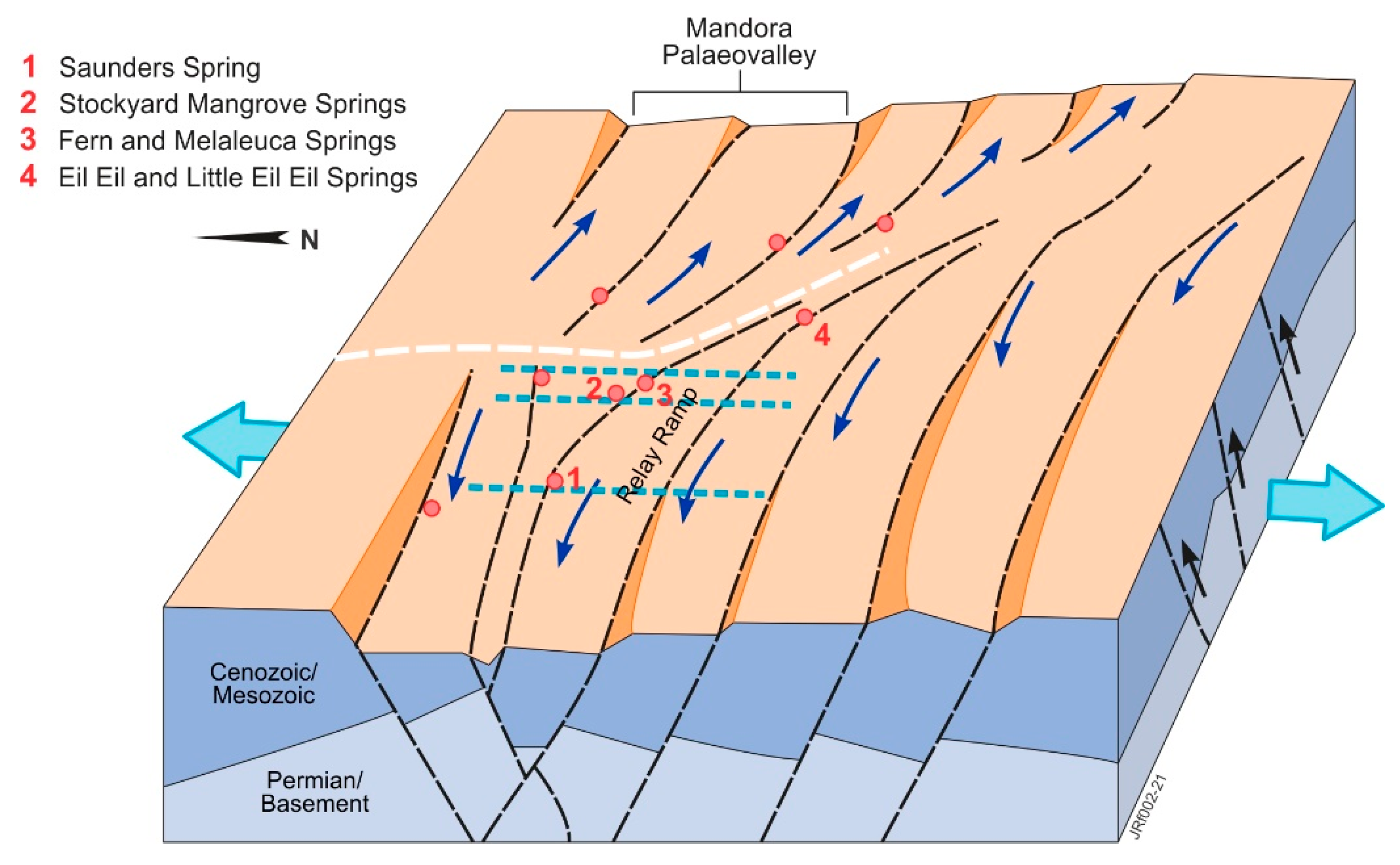
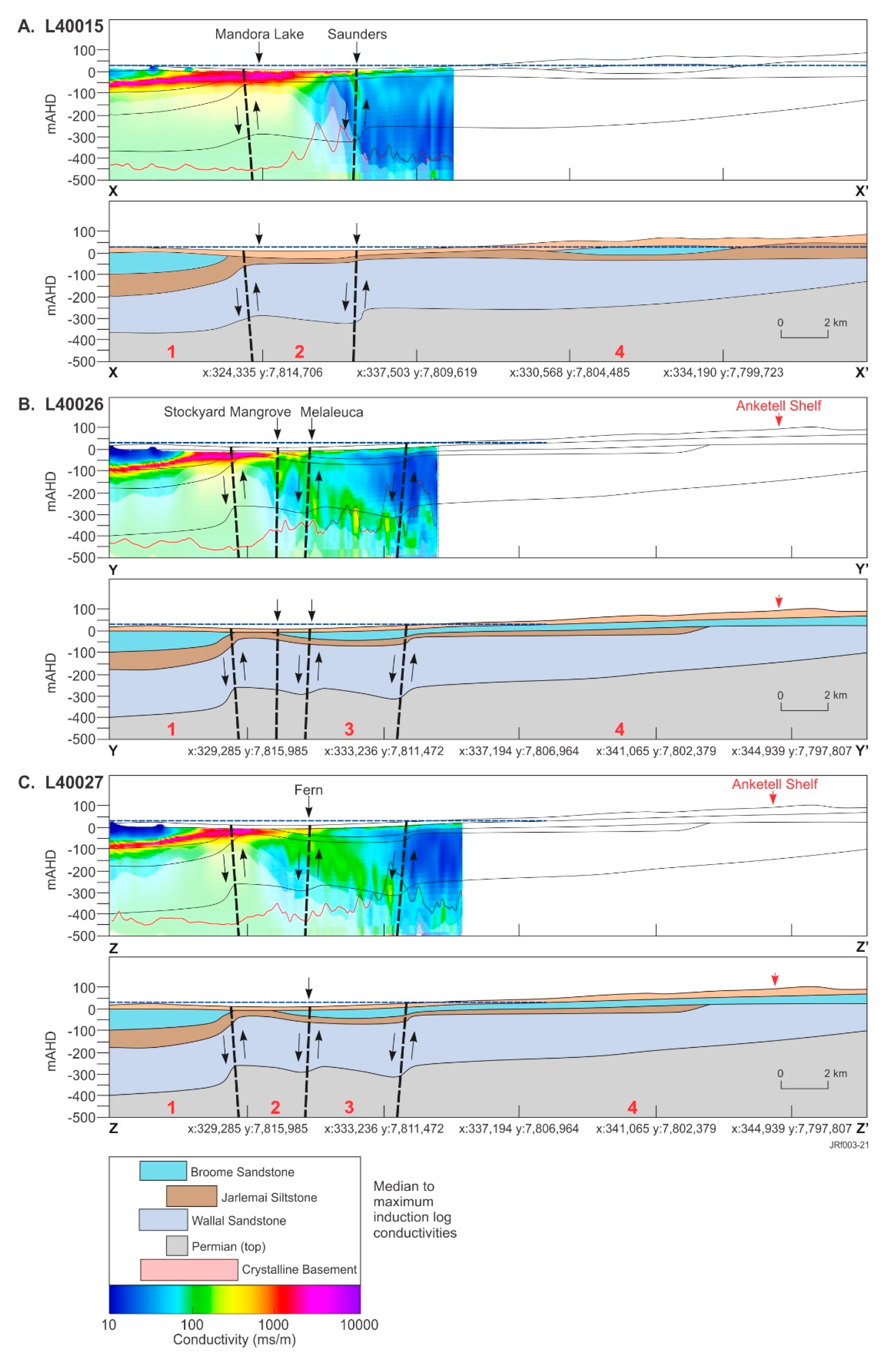


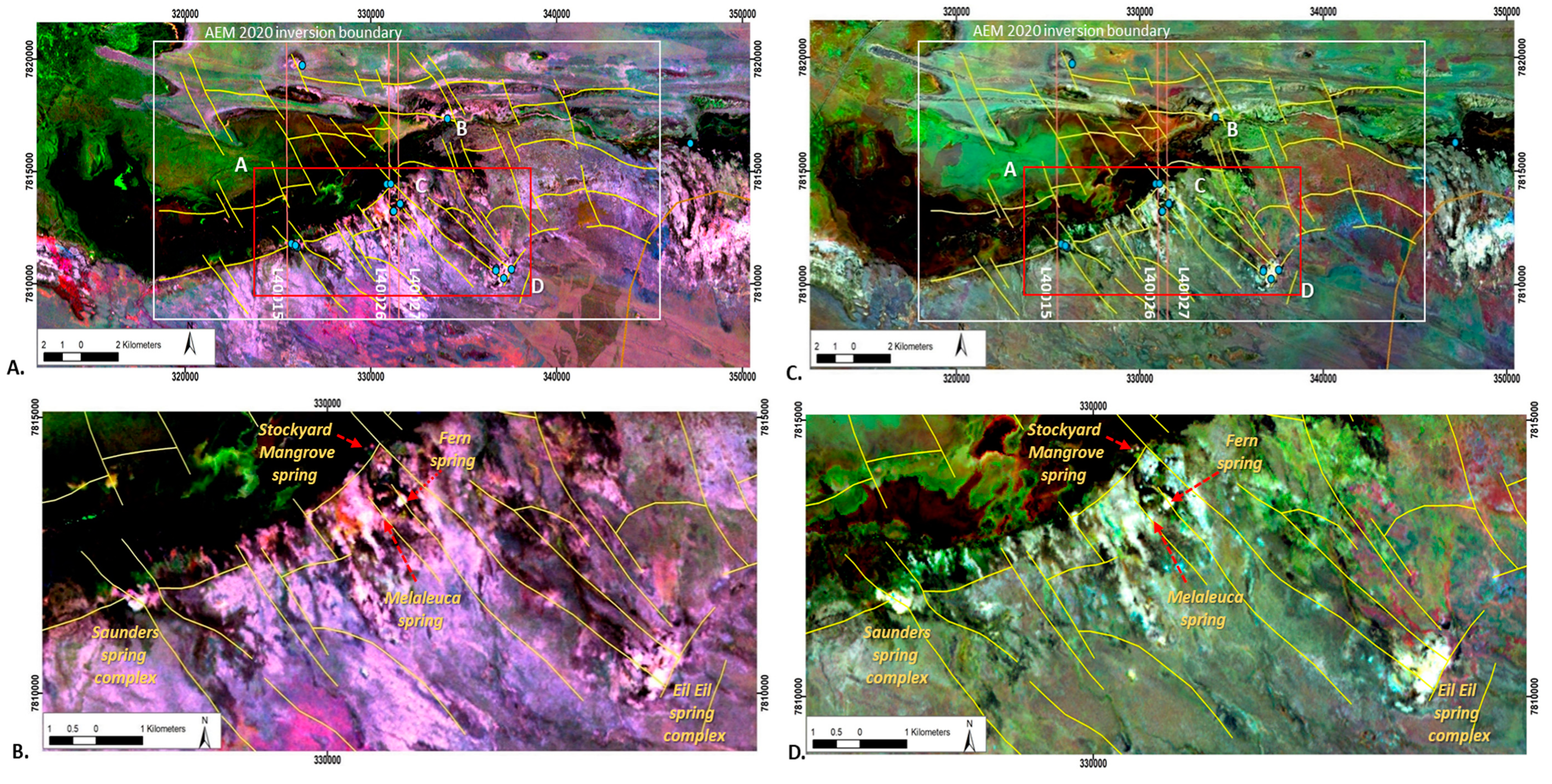

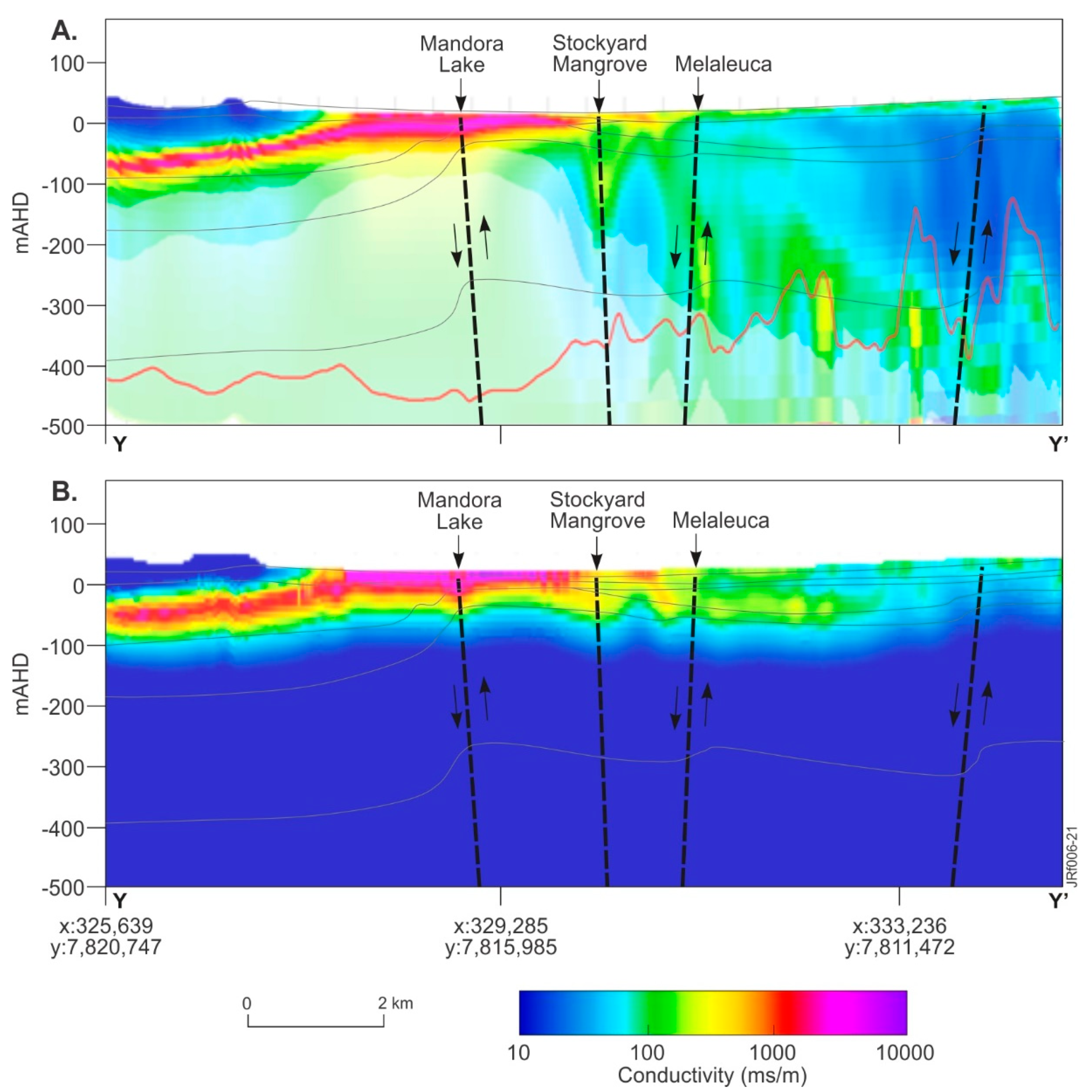
Publisher’s Note: MDPI stays neutral with regard to jurisdictional claims in published maps and institutional affiliations. |
© 2021 by the authors. Licensee MDPI, Basel, Switzerland. This article is an open access article distributed under the terms and conditions of the Creative Commons Attribution (CC BY) license (http://creativecommons.org/licenses/by/4.0/).
Share and Cite
Rutherford, J.; Ibrahimi, T.; Munday, T.; Markey, A.; Viezzoli, A.; Rapiti, A.; Paterson, R. An Assessment of Water Sources for Heritage Listed Organic Mound Springs in NW Australia Using Airborne Geophysical (Electromagnetics and Magnetics) and Satellite Remote Sensing Methods. Remote Sens. 2021, 13, 1288. https://doi.org/10.3390/rs13071288
Rutherford J, Ibrahimi T, Munday T, Markey A, Viezzoli A, Rapiti A, Paterson R. An Assessment of Water Sources for Heritage Listed Organic Mound Springs in NW Australia Using Airborne Geophysical (Electromagnetics and Magnetics) and Satellite Remote Sensing Methods. Remote Sensing. 2021; 13(7):1288. https://doi.org/10.3390/rs13071288
Chicago/Turabian StyleRutherford, Jasmine, Tania Ibrahimi, Tim Munday, Adrienne Markey, Andrea Viezzoli, Arianna Rapiti, and Rod Paterson. 2021. "An Assessment of Water Sources for Heritage Listed Organic Mound Springs in NW Australia Using Airborne Geophysical (Electromagnetics and Magnetics) and Satellite Remote Sensing Methods" Remote Sensing 13, no. 7: 1288. https://doi.org/10.3390/rs13071288
APA StyleRutherford, J., Ibrahimi, T., Munday, T., Markey, A., Viezzoli, A., Rapiti, A., & Paterson, R. (2021). An Assessment of Water Sources for Heritage Listed Organic Mound Springs in NW Australia Using Airborne Geophysical (Electromagnetics and Magnetics) and Satellite Remote Sensing Methods. Remote Sensing, 13(7), 1288. https://doi.org/10.3390/rs13071288




